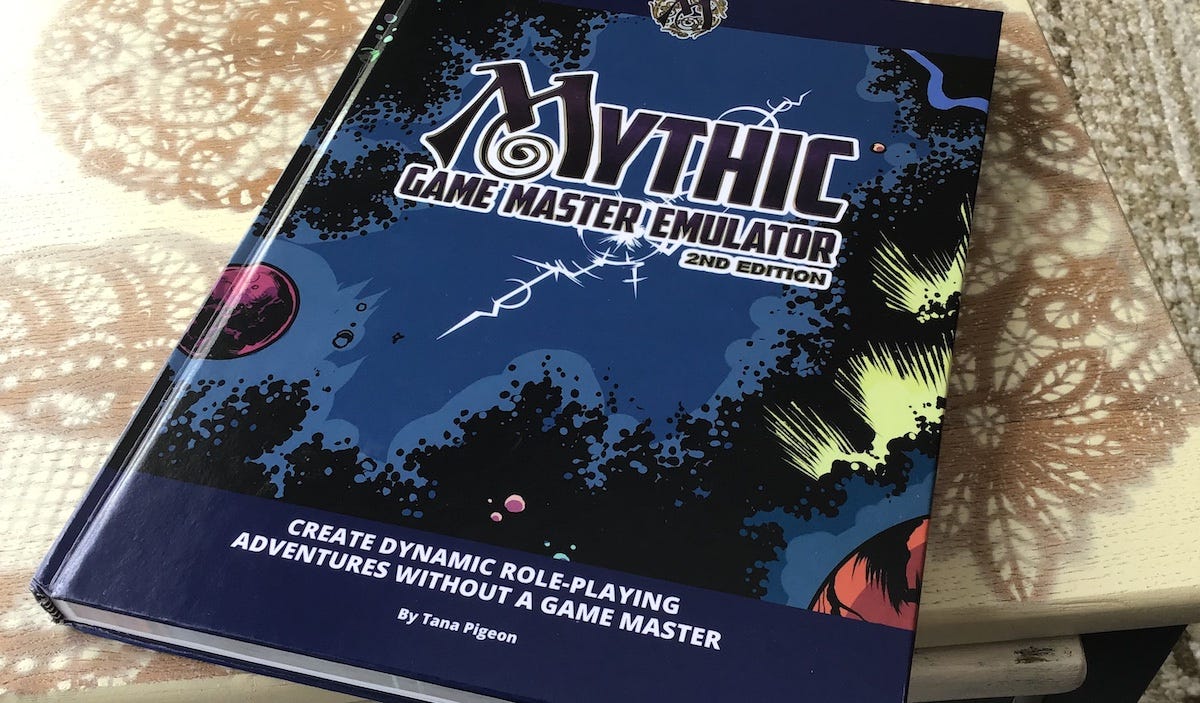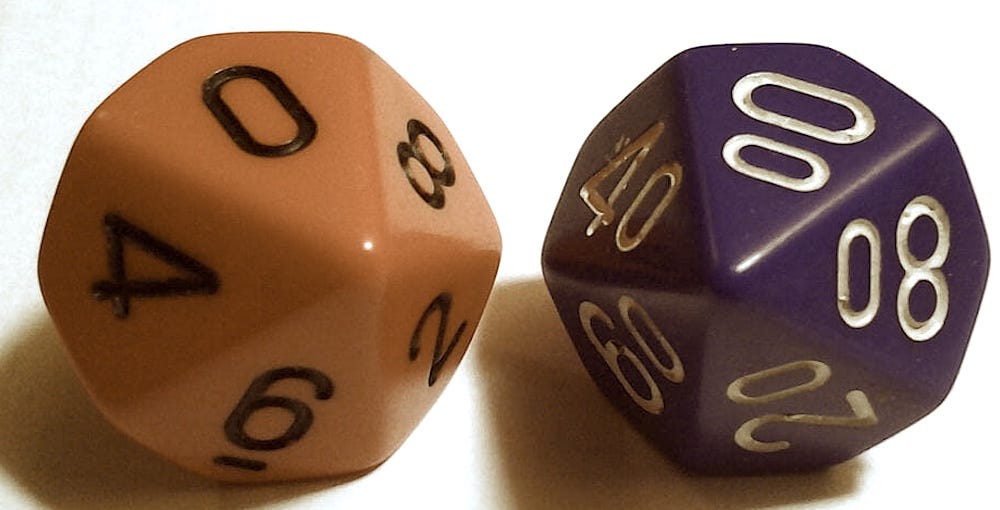Rolling Without a GM: When Mythic Takes the Wheel
Review of Mythic Game Master Emulator (2nd Edition) by Tana Pigeon
First released in 2003 and followed by a significantly revised Second Edition in 2023, Tana Pigeon’s Mythic is not merely a solo RPG toolset; it represents a philosophy of play, an open-ended engine for spontaneous storytelling, and arguably the most influential framework in the niche world of solo roleplaying games.
That’s a big, bold claim for this 226-page monster I’ve been reading (and re-reading) for the past week. The physical book ain’t cheap—I couldn’t find a copy here in the UK for under £50, so I was aiming high with my expectations.
So, allow me to explain my opening statement.
Since I accidentally stumbled upon the world of solo roleplaying a few months ago, I’ve been diving deep into systems, rule sets, philosophies, and mindsets.
It’s been something of a head-spinning journey.
But with Mythic Game Master Emulator, I feel the disparate pieces have begun to coalesce.
Mythic is not just a tool—it’s an invitation. It encourages me to trust myself, embrace the unknown, and allow my story to be shaped by whim, chance, and curiosity. While it may not suit players who crave rigid structure or GM-led play, it's a transformative experience for solo roleplayers and imaginative explorers.
If we want to tell stories that surprise even ourselves, if we want our characters to stumble into events neither planned nor predicted, if we want to see what it’s like to play an RPG where the world itself seems alive with potential, Mythic is our map, compass, and chaos incarnate all rolled into one!
Several key pillars make Mythic function. Let’s take a quick look at them:
Fate ChartThe Fate Chart is Mythic’s primary resolution engine. We pose a Yes/No question and roll percentile dice to determine the answer, considering a “likelihood” level and the game’s current Chaos Factor—a dynamic gauge of how out of control or unstable the story has become. The system also accommodates “Exceptional Yes” or “Exceptional No” results, encouraging bold narrative twists.Chaos FactorOne of Mythic’s most innovative elements is the Chaos Factor, a number ranging from 1 to 9 that continuously shifts as the game evolves. If our story begins in chaos (a jailbreak, a demon invasion, etc.), a higher Chaos Factor will increase the likelihood of wild outcomes and unexpected interruptions. In contrast, lower chaos levels indicate calm and control.Scene StructureMythic organises our game into discrete scenes, much like a TV show or movie. Before each scene, we determine what should “logically” happen next, and then roll to see if the scene is altered or interrupted. This setup ensures we’re not just wandering aimlessly through plot points; the system builds suspense and pacing organically.Random Events and Meaning Tables:One of Mythic’s secret storytelling weapons is its Event Focus and Meaning tables. These provide prompts like “NPC Action” or “Introduce a New Character,” paired with evocative word pairs such as “Violently / History” or “Carelessness / Tension.” While these tools may sound vague, in practice, they serve as narrative accelerators, igniting the imagination at just the right moment.Threads and CharactersPlayers are encouraged to monitor open plot threads and active characters. The system can then reintroduce or complicate these elements at dramatic points, ensuring the narrative remains tight and interconnected—no small feat in a solo game.
Listen, I get it. Mythic is probably not for everyone. Plenty of people on Reddit discuss how the meaning tables leave things too open-ended. People ask what they are supposed to do with, for example, a roll of “Proceed” and “Balance.” The book suggests a few ways to deal with vague obscurity—switching the digits, re-rolling or simply ignoring the meaning tables and going with our gut!
But we’re all different, aren’t we? Some can allow prompts to spark an emerging narrative, while others prefer a more tightly constrained story. Horses for courses…
Let’s bullet-point some of the strengths of Mythic.
VersatilityMythic isn’t tied to any genre or setting. It’s system-agnostic, meaning we can use it with any RPG we like—or not at all. Some players even use it for creative writing prompts or world-building exercises.AccessibilityDespite its depth, Mythic is fairly easy to learn. The Second Edition enhances this clarity with streamlined rules, improved tables, and updated guidance based on two decades of user feedback.Emergent StorytellingMythic doesn’t create a plot for us, but it provokes one. With the right mindset, every roll becomes a creative challenge. It's less about “winning” and more about seeing where the story goes.Replay ValueNo two Mythic sessions are alike. With a handful of questions and a few dice rolls, we can find ourselves embroiled in political conspiracies, ancient prophecies, or haunted hotel mysteries—often all at onceFinally, the
Chaos Factormakes pacing and escalation intuitive. As things spiral, the system ensures that the narrative reflects the mounting tension. And when things settle down, it rewards us with calmer, more predictable outcomes.
Of course, Mythic is not without its challenges.
It requires Creative EnergyWhile Mythic decreases prep time, it necessitates mental improvisation. WE are the actor, director, and editor of our own narrative. On a tired day, this can feel more like work than play…Scene Framing Can Be Vague: For beginners, the structure of a scene may feel a bit loose. The idea that every scene begins with a setup, a Chaos Factor check, and then proceeds with reactive questioning might seem mechanical at first, until we get the hang of it.The Fate Chartmight be seen as overly fiddly to some. While the 2e has apparently simplified this, a degree of procedural work is still required that can feel mechanical before it becomes intuitive.It requires bookkeeping. To maximise your experience with Mythic, especially during long-term play, we need to keep track of threads, characters, and world details. Without these bookkeeping elements, the emergent narrative may begin to lose cohesion.
Tana Pigeon has done something remarkable with Mythic and created a tool that lets us surprise ourselves. That’s no easy feat in a solo RPG, where the risk of railroading or boredom always lurks. However, mythic sidesteps that problem by acting not as a storyteller but as a collaborator.
It gives us structure without stealing control.
For players seeking a rich solo experience, Mythic is less a product than a partner. It will challenge our improvisation muscles, test our trust in the dice, and reward us with stories that feel authored by something beyond ourselves.
Whether we’re exploring alien planets, ancient tombs, or our subconscious, Mythic makes the journey worth taking.
Be sure to subscribe to this Substack as I launch my first Mythic-powered campaign, as I throw myself into the Wastelands of post-apocalyptic America with Modiphius’ Fallout 2d20 RPG.
And don’t think Olvir the Forgotten will be…ummm… forgotten. I’ll still be exploring the Ironlands for a long time to come. In fact, I’ve already played out the next episode—I just need to get it written up now!





Looking forward to seeing how you get on with it with Fallout. I’ve found it to be invaluable with The Electric State. The twists and turns it generates and the challenges to your expectations make for a rich and rewarding adventure.
Thanks for this review! I was curious about this product